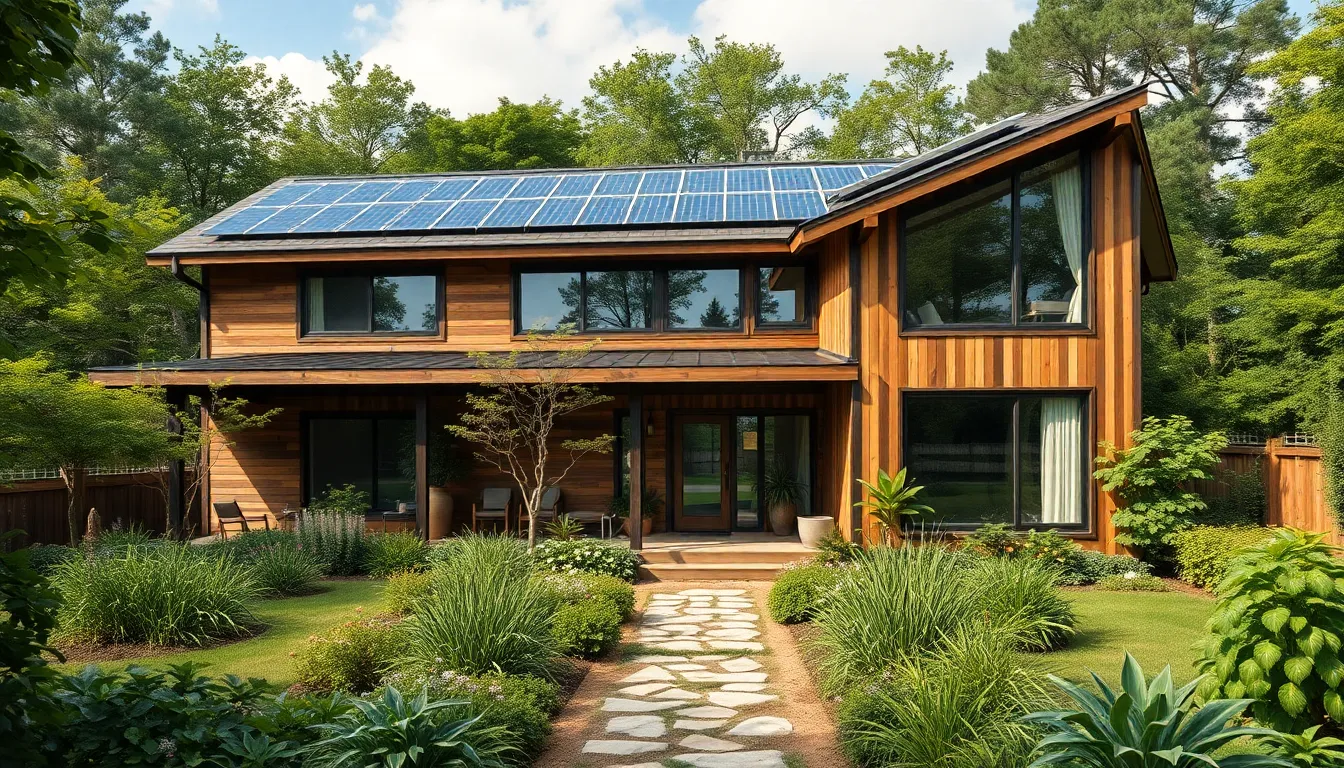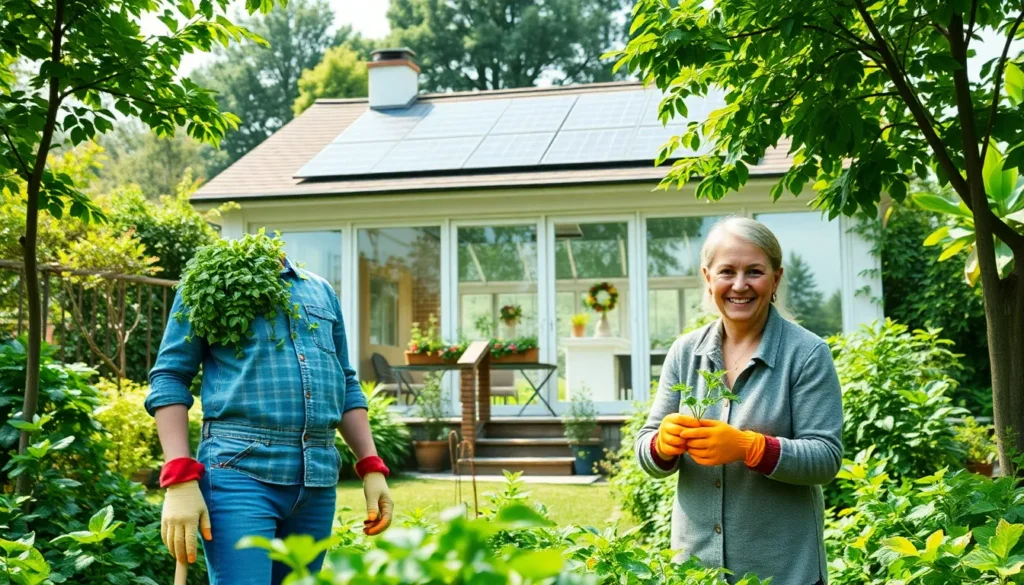As awareness of environmental issues grows, more people are seeking ways to create sustainable living spaces. Eco-friendly home designs not only prioritize the planet but also enhance the quality of life for their inhabitants. By incorporating natural materials, energy-efficient systems, and innovative layouts, these homes reflect a commitment to sustainability without sacrificing style or comfort.
From solar panels to rainwater harvesting systems, eco-friendly features are becoming increasingly accessible and appealing. Homeowners are now recognizing that green living can lead to significant savings on utility bills while reducing their carbon footprint. Embracing eco-friendly design isn’t just a trend; it’s a lifestyle choice that fosters a healthier environment for future generations.
Table of Contents
ToggleImportance Of Eco-Friendly Home Designs
Eco-friendly home designs play a crucial role in promoting sustainable living. These designs not only address environmental concerns but also offer substantial benefits to homeowners.
Environmental Impact
Eco-friendly home designs significantly reduce environmental impact. They incorporate sustainable materials, such as reclaimed wood, bamboo, and recycled metal. These materials minimize resource depletion and pollution. Energy-efficient systems, including solar panels and smart thermostats, lower energy consumption and greenhouse gas emissions. Water-saving features, like low-flow fixtures and rainwater harvesting systems, help conserve this vital resource. Overall, eco-friendly designs encourage biodiversity and promote healthier ecosystems by preserving natural habitats.
Economic Benefits
Economic benefits arise from adopting eco-friendly home designs. Homeowners often experience reduced utility bills due to energy-efficient systems and sustainable materials. For example, homes equipped with solar panels can save thousands on electricity over the system’s lifespan. Additionally, many regions offer tax incentives and rebates for eco-friendly upgrades, offsetting initial investment costs. Increased property values also accompany energy-efficient homes, as buyers increasingly seek sustainable living options. Therefore, eco-friendly designs yield long-term financial savings while enhancing quality of life.
Key Features Of Eco-Friendly Home Designs

Eco-friendly home designs incorporate features that promote sustainability, reduce energy consumption, and mitigate environmental impact. Key elements often include the use of sustainable materials and energy-efficient technologies.
Sustainable Materials
Sustainable materials contribute significantly to eco-friendly home designs. These materials minimize environmental impact and enhance indoor air quality. Key examples include:
- Recycled materials: Utilizing reclaimed wood, recycled metal, and glass minimizes waste and reduces the need for new raw materials.
- Bamboo products: Bamboo grows quickly and absorbs carbon dioxide efficiently, making it a highly renewable choice for flooring and cabinetry.
- Natural insulation: Materials like recycled denim or sheep’s wool offer effective thermal insulation while maintaining a low environmental footprint.
- Low-VOC paints: These paints reduce harmful emissions, improving indoor air quality and promoting a healthier living environment.
Energy Efficiency
Energy efficiency plays a crucial role in eco-friendly home designs. Implementing energy-efficient solutions can lower energy consumption and reduce utility costs. Important components include:
- Solar panels: Installing solar panels harnesses renewable energy, significantly lowering dependency on fossil fuels and decreasing energy bills.
- Energy-efficient appliances: Selecting appliances with the ENERGY STAR label ensures lower energy use, leading to long-term savings.
- High-performance windows: Energy-efficient windows regulate indoor temperature more effectively, reducing heating and cooling costs.
- Smart home technology: Integrating smart thermostats and lighting systems optimizes energy use based on occupancy and time of day, enhancing overall efficiency.
Adopting these key features in home designs not only supports a sustainable lifestyle but also provides enduring benefits for homeowners and the environment.
Popular Eco-Friendly Home Design Styles
Various eco-friendly home design styles cater to sustainable living preferences, promoting environmental responsibility while enhancing comfort. Two popular styles are Minimalist Design and Biophilic Design.
Minimalist Design
Minimalist design emphasizes simplicity, functionality, and the efficient use of space. This style incorporates natural materials like wood, stone, and metal, promoting sustainability and reducing waste. Colors often remain neutral, creating a calm, inviting atmosphere.
Homeowners favor this approach because it typically lowers maintenance costs and resource consumption. Energy-efficient appliances and fixtures are standard, supporting low energy demands. Minimalism encourages decluttering, which results in a more orderly living environment and an overall focus on quality over quantity.
Biophilic Design
Biophilic design integrates nature into the built environment. This style enhances residents’ connection to outdoor elements, promoting well-being and sustainability. Incorporating large windows, living walls, and open spaces connects indoor areas with natural surroundings.
Natural light plays a key role, reducing reliance on artificial lighting and improving energy efficiency. Additionally, biophilic spaces often include indoor plants and natural water features, enhancing air quality and reducing stress. This design approach aligns with eco-friendly principles by creating healthier living environments while emphasizing the importance of nature in daily life.
Tips For Implementing Eco-Friendly Practices
Implementing eco-friendly practices in home designs enhances sustainability and improves the living environment. This approach focuses on resource efficiency and conservation, aligning with the broader goal of reducing environmental impact.
Choosing Renewable Resources
Choosing renewable resources is vital for sustainable home design. Use materials like bamboo, which grows rapidly and regenerates quickly. Select recycled materials, such as reclaimed wood and recycled metal, to minimize waste and reduce the need for new resource extraction. Opt for solar panels that harness solar energy, providing clean power and lowering utility costs. Incorporate sustainable insulation options like wool or cellulose, which maintain thermal performance while minimizing harm to ecosystems. Prioritizing these resources fosters a healthier planet and creates durable living spaces.
Efficient Water Management
Efficient water management plays a key role in minimizing environmental impact. Install low-flow fixtures, like faucets, showerheads, and toilets, to reduce water consumption without sacrificing performance. Utilize gray water systems to recycle water from sinks and showers for irrigation or toilet flushing. Implement rainwater harvesting systems to collect rainwater for landscaping and gardens, thus conserving potable water. Design landscapes with drought-resistant plants that require less watering, contributing to more sustainable yard maintenance. Focusing on efficient water management practices promotes resource conservation and supports a sustainable lifestyle.
Embracing eco-friendly home designs is more than just a trend; it’s a commitment to a sustainable future. By incorporating innovative features and materials, homeowners can create spaces that not only enhance their living experience but also contribute positively to the environment.
With options like solar panels and sustainable materials becoming more accessible, making eco-conscious choices is easier than ever. These designs not only promote a healthier lifestyle but also offer long-term financial benefits.
As individuals continue to prioritize sustainability, eco-friendly home designs will play a crucial role in shaping a greener, more responsible way of living for generations to come.





